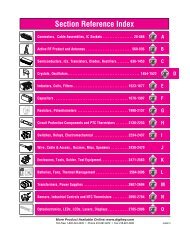Microcontroller Solutions TechZone Magazine, April 2011 - Digikey
Microcontroller Solutions TechZone Magazine, April 2011 - Digikey
Microcontroller Solutions TechZone Magazine, April 2011 - Digikey
You also want an ePaper? Increase the reach of your titles
YUMPU automatically turns print PDFs into web optimized ePapers that Google loves.
Table 1: USB 2.0 versus 3.0. (Used with permission from USB-IF).<br />
Characteristic USB 2.0 USB 3.0<br />
Data rate Low-speed (1.5 Mbps), full-speed (12<br />
Mbps), and high-speed (480 Mbps).<br />
Data<br />
interface<br />
Cable signal<br />
count<br />
Bus transaction<br />
protocol<br />
Power<br />
management<br />
Bus power<br />
Port state<br />
Data transfer<br />
types<br />
Half-duplex, two-wire differential<br />
signaling. Unidirectional data fl ow<br />
with negotiated directional bus<br />
transitions.<br />
Two: two for low-/full-/high- speed<br />
data path.<br />
Host directed, polled traffic flow. Packet<br />
traffic is broadcast to all devices.<br />
Port-level suspend with tow levels<br />
of entry/exit latency. Device-level<br />
power management.<br />
Support for low/high bus-powered<br />
devices with lower power limits for<br />
unconfigured and suspended devices.<br />
Port hardware detects connect<br />
events. System software uses port<br />
command to transitions the port<br />
into an enabled state (USB data<br />
communication fl ows).<br />
Four data transfer types: control,<br />
bulk, Interrupt, and Isochronous.<br />
SuperSpeed (5.0 Gpbs).<br />
Dual-simplex, four-wire differential<br />
signaling separate from USB<br />
2.0 signaling. Simultaneous<br />
bi-directional data fl ows.<br />
Six: four for SuperSpeed data path.<br />
Two for non-SuperSpeed data path.<br />
Host directed, asynchronous traffi c<br />
fl ow. Packet traffi c is explicitly routed.<br />
Multi-level link power management<br />
supporting idle, sleep, and suspend<br />
states. Link-, Device-, and Functionlevel<br />
power management.<br />
Same as for USB 2.0 with a 50%<br />
increase for unconfigured power and<br />
an 80% increase for configured power.<br />
Port hardware detects connect<br />
events and brings the port into<br />
operational state ready for<br />
SuperSpeed data communication.<br />
USB 2.0 types with SuperSpeed<br />
constraints. Bulk has streams<br />
capability.<br />
More importantly, SuperSpeed USB enables considerable power<br />
savings by enabling both upstream and downstream ports to initiate<br />
lower power states on the link. In addition, multiple link power<br />
states are defi ned, enabling local power management control and,<br />
therefore, improved power usage effi ciency. Eliminating polling<br />
and broadcasting also went a long way toward reducing power<br />
requirements. Finally, the increased speed and effi ciency of USB<br />
3.0 bus, combined with the ability to use data streaming for bulk<br />
transfers, further reduces the power profi le of these devices.<br />
Typically, the faster a data transfer completes, the faster system<br />
components can return to a low-power state. The USB-IF estimates<br />
the system power necessary to complete a 20 MB SuperSpeed data<br />
transfer will be 25 percent lower than is possible using USB 2.0.<br />
The SuperSpeed specifi cation brings over Link Power Management<br />
(LPM) from USB 2.0. LPM was fi rst introduced in the Enhanced Host<br />
Controller Interface (EHCI) to accommodate high-speed, PCI-based<br />
USB interfaces. Because of the diffi culty of implementing it, LPM was<br />
slow to appear in USB 2.0 devices. It is now required in USB 3.0 and<br />
for SuperSpeed devices supporting legacy high-speed peripherals.<br />
LPM is an adaptive power management model that uses link-state<br />
awareness to reduce power usage.<br />
LPM defi nes a fast host transition from an enabled state to L1<br />
Sleep (~10 µs) or L2 Suspend (after 3 ms of inactivity). Return from<br />
L1 sleep varies from ~70 µs to 1 ms; return from L2 Suspend mode is<br />
OS dependent. The fast transitions and close control of power at the<br />
link level enables LPM to manage power consumption in SuperSpeed<br />
systems with greater precision than was previously possible.<br />
Link power management enables a link to be placed into a lower<br />
power state when the link partners are idle. The longer a pair of<br />
link partners remain idle, the deeper the power savings that can<br />
be achieved by progressing from UO (link active) to Ul (link standby<br />
with fast exit) to U2 (link standby with slower exit), and fi nally to U3<br />
(suspend). Table 2 summarizes the logical link states.<br />
Table 2: Logical link states. (Used with permission from USB-IF).<br />
Link State Description Key Characteristics Device Clock Exit Latency<br />
U0 Link active - On N/A<br />
U1 Link idle, fast exit RX & TX quiesced On or off µs<br />
U2 Link idle, slow exit Clock gen circuit also On or off µs-ms<br />
quiesced<br />
U3 Suspend Portions of device power<br />
removed<br />
Off<br />
ms<br />
Most SuperSpeed devices, sensing inactivity on the link, will<br />
automatically reduce power to the PHY and transition from U0 to U1.<br />
Further inactivity will cause these devices to progressively lower<br />
power. The host or devices may further idle the link (U2), or the host<br />
may even suspend it (U3).<br />
Both devices and downstream ports can initiate Ul and U2 entry.<br />
Downstream ports have inactivity timers used to initiate Ul and U2<br />
entry. Downstream port inactivity timeouts are programmed by system<br />
software. Devices may have additional information available that they can<br />
use to decide to initiate Ul or U2 entry more aggressively than inactivity<br />
timers. Devices can save significant power by initiating Ul or U2 more<br />
aggressively rather than waiting for downstream port inactivity timeouts.<br />
While the advantages of SuperSpeed USB are impressive, these<br />
devices are just beginning to appear in a world dominated by USB 2.0.<br />
For backward, compatibility SuperSpeed devices must support both<br />
USB 2.0 and 3.0 link speeds, maintaining separate controllers and<br />
PHYs for full-speed, high-speed and SuperSpeed links. By maintaining<br />
a parallel system to support legacy devices, SuperSpeed’s designers<br />
accepted higher cost and complexity as a price worth paying to avoid<br />
compromising the speed advantage of their new architecture.<br />
Adoption ramp<br />
No new standard, whatever its technical advantages, is adopted<br />
overnight. That is certainly true with USB 3.0, which needs to<br />
see a critical mass of devices in the fi eld before it will take off.<br />
Since consumers have long been content with USB 2.0, and since<br />
SuperSpeed devices will initially be more expensive, consumers<br />
will need to be convinced of compelling application benefi ts before<br />
it is likely to see broad adoption. Streaming multimedia is almost<br />
undoubtedly the killer app that will make this happen.<br />
One of the major things holding back USB 3.0 is the lack of support<br />
for it in core logic chipsets. Intel made much of its support for the<br />
standard at IDF 2009, and there was plenty of talk about it at the<br />
USB pavilion. However, at IDF 2010 Intel made no production silicon<br />
announcements—reportedly because of the diffi culty of developing<br />
bug-free silicon—and there does not appear to be any plan to include<br />
it in either Sandy Bridge or Atom processors for the next year or so.<br />
Intel’s apparent hesitation about supporting the standard will clearly<br />
stall its adoption in the marketplace and give Intel-based embedded<br />
developers pause about including it in their designs. Despite its recent<br />
hesitation, Intel will almost undoubtedly support USB 3.0 by next year.<br />
Meanwhile, the USB-IF announced more than 100 SuperSpeedcertifi<br />
ed products at IDF 2010, so this train, while still getting up<br />
to speed, has clearly left the station. It is now up to embedded<br />
developers to determine whether USB 3.0 is appropriate for their<br />
applications, and if so, to get on board.<br />
66














